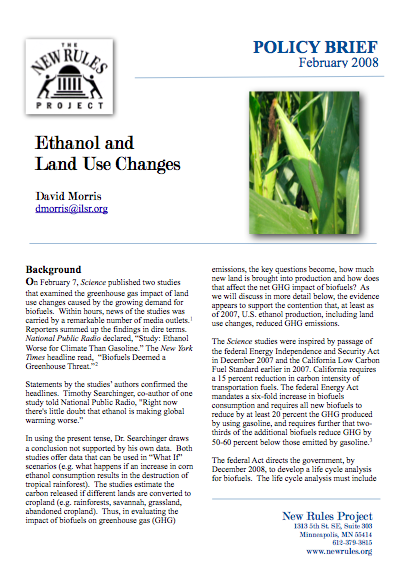This February 2008 report by David Morris criticizes the authors of two recent studies published in Sciencefor advancing a conclusion not supported by their own studies. The paper notes that the vast majority of today’s ethanol production comes from corn cultivated on land that has been in corn production for generations. Since little new land has come into production, either directly or in directly, the current use of ethanol clearly reduces greenhouse gas emissions.
On February 7, 2008, Science published two studies that examined the greenhouse gas impact of land use changes caused by the growing demand for biofuels. Within hours, news of the studies was carried by a remarkable number of media outlets. Reporters summed up the findings in dire terms. National Public Radio declared, “Study: Ethanol Worse for Climate Than Gasoline.” The New York Times headline read, “Biofuels Deemed a Greenhouse Threat.”
Statements by the studies’ authors confirmed the headlines. Timothy Searchinger, co-author of one study told National Public Radio, “Right now there’s little doubt that ethanol is making global warming worse.”
In using the present tense, Dr. Searchinger draws a conclusion not supported by his own data. Both studies offer data that can be used in “What If” scenarios (e.g. what happens if an increase in corn ethanol consumption results in the destruction of tropical rainforest). The studies estimate the carbon released if different lands are converted to cropland (e.g. rainforests, savannah, grassland, abandoned cropland). Thus, in evaluating the impact of biofuels on greenhouse gas (GHG) emissions, the key questions become, how much new land is brought into production and how does that affect the net GHG impact of biofuels?
As we discuss in the full policy brief, contrary to the published statements of Dr. Searchinger, the evidence appears to support the contention that, at least as of 2007, U.S. ethanol production, including land use changes, reduced GHG emissions.
The impact of direct land use changes can be empirically determined. The impact of indirect land use changes, however, moves us into a more speculative area.



